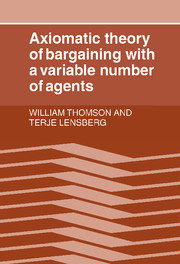Book contents
- Frontmatter
- Contents
- Acknowledgments
- List of symbols and notation
- List of axioms
- 1 Preliminaries
- 2 Axiomatic theory of bargaining with a fixed number of agents
- 3 Population Monotonicity and the Kalai–Smorodinsky solution
- 4 Population Monotonicity and the Egalitarian solution
- 5 Truncated Egalitarian and Monotone Path solutions
- 6 Guarantees and opportunities
- 7 Stability and the Nash solution
- 8 Stability without Pareto-Optimality
- 9 Stability and the Leximin solution
- 10 Population Monotonicity, Weak Stability, and the Egalitarian solution
- 11 Stability and Collectively Rational solutions
- 12 Invariance under Replication and Juxtaposition
- Bibliography
- Index
7 - Stability and the Nash solution
Published online by Cambridge University Press: 23 March 2010
- Frontmatter
- Contents
- Acknowledgments
- List of symbols and notation
- List of axioms
- 1 Preliminaries
- 2 Axiomatic theory of bargaining with a fixed number of agents
- 3 Population Monotonicity and the Kalai–Smorodinsky solution
- 4 Population Monotonicity and the Egalitarian solution
- 5 Truncated Egalitarian and Monotone Path solutions
- 6 Guarantees and opportunities
- 7 Stability and the Nash solution
- 8 Stability without Pareto-Optimality
- 9 Stability and the Leximin solution
- 10 Population Monotonicity, Weak Stability, and the Egalitarian solution
- 11 Stability and Collectively Rational solutions
- 12 Invariance under Replication and Juxtaposition
- Bibliography
- Index
Summary
Introduction
The focus of this chapter is on the Nash solution. We offer a new characterization of this solution based on several standard axioms already introduced and discussed in previous chapters and a new axiom, similar to the Population Monotonicity axiom, that concerns the behavior of solutions across cardinalities. Loosely speaking, this axiom says that the outcome selected for a particular problem should be best not only for that problem but also for the subproblem faced by any subgroup, consisting of all the feasible alternatives at which the utilities of all the agents not in the subgroup are kept at the levels specified by the proposed outcome.
The characterization offered here differs from the classic characterization of the Nash solution (see Chapter 2) in that no use is made of the axiom of Independence of Irrelevant Alternatives, whose role is played by this new axiom.
The characterization of the two-person Nash solution, given by Nash in his original paper, has indeed been criticized for its reliance on the independence axiom. Although there are good reasons why one may want to impose it (recall our discussion of the axiom in Chapter 4), it would be of interest to develop results that do not rely on it. It is in that spirit that another axiom will be used instead. This axiom will turn out to play a role very similar to that played by the independence axiom, but its normative significance is quite different.
- Type
- Chapter
- Information
- Publisher: Cambridge University PressPrint publication year: 1989



